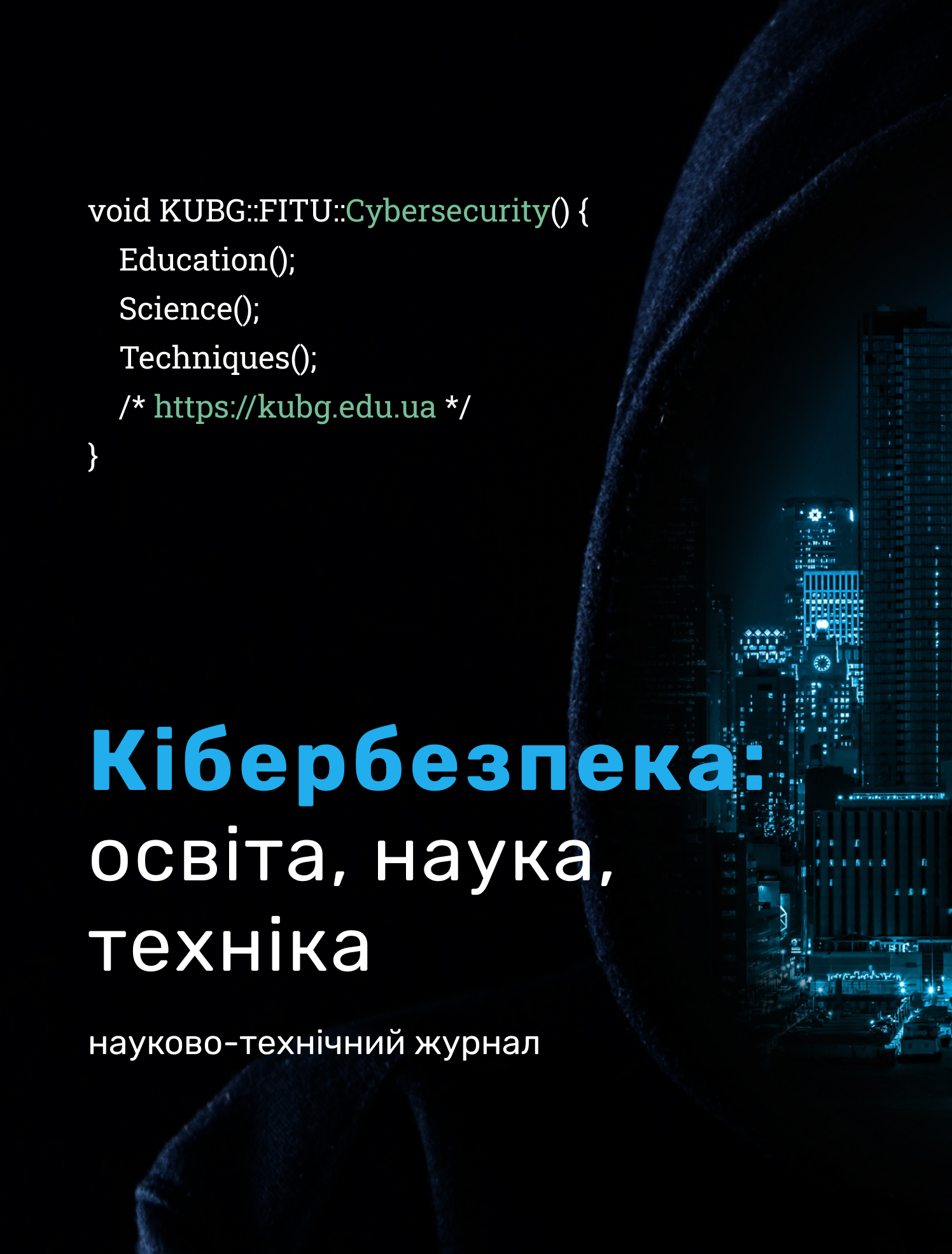ПРАКТИЧНА СХЕМА ГІБРИДНОГО ГЕНЕРАТОРА ПСЕВДОВИПАДКОВИХ ПОСЛІДОВНОСТЕЙ НА ОСНОВІ АУДІОЕНТРОПІЇ ТА НЕЛІНІЙНИХ БУЛЕВИХ ФУНКЦІЙ
DOI:
https://doi.org/10.28925/2663-4023.2025.30.959Ключові слова:
генератор псевдовипадкових послідовностей, булеві функції, нелінійність, аудіоентропія, генератор Джиффі, криптографічна стійкість, NIST STS, кібербезпекаАнотація
У статті вирішено актуальну задачу генерації криптостійких псевдовипадкових послідовностей (ПВП) для забезпечення кібербезпеки сучасних цифрових систем. Генератори ПВП відіграють ключову роль у формуванні ключів шифрування, ініціалізаційних векторів, одноразових токенів автентифікації та інших критичних параметрів криптографічних протоколів. Недостатня криптостійкість таких генераторів може призвести до компрометації надійних протоколів, що підкреслює необхідність розробки нових методів, які долають обмеження традиційних детерміністичних підходів. Серед цих обмежень – передбачуваність послідовностей у разі розкриття внутрішнього стану, обмежена ентропія початкових значень, вразливість до статистичних атак та відсутність справжньої випадковості, що знижує ефективність у криптографічних застосуваннях. У статті запропоновано і реалізовано практичну схему побудови гібридного генератора псевдовипадкових послідовностей, що поєднує аудіоентропію та нелінійні булеві функції в алгебраїчній нормальній формі (АНФ). Архітектура базується на динамічному синтезі вихідних послідовностей модифікованих генераторів Джиффі за допомогою АНФ-функцій з високою нелінійністю, які генеруються випадково. Аудіоентропія, отримана з природного шуму мікрофона, використовується для ініціалізації початкових станів генераторів, що підвищує непередбачуваність послідовностей. Базою архітектури слугує модифікований генератор Джиффі з гнучкими параметрами регістрів зсуву (довжини 47, 53 та 59 бітів), фіксованими зворотними зв’язками на основі характеристичних поліномів із простими числами та статичними конфігураціями вихідної функції. Особливий акцент зроблено на використанні алгебраїчної нормальної форми (АНФ) булевих функцій, які дозволяють ефективно аналізувати та оптимізувати властивості нелінійності, кореляційної стійкості та складності криптоаналізу. Запропонована гібридна архітектура поєднує фізичні джерела ентропії з ефективними алгоритмами псевдовипадкової генерації, досягаючи балансу між непередбачуваністю та продуктивністю. Це актуально для вбудованих пристроїв та систем Інтернету речей (IoT), де обмежені обчислювальні ресурси, відсутні класичні джерела ентропії, а також існують вимоги до енергоефективності та реального часу. Проведене комплексне тестування за допомогою NIST SP 800-22 підтвердило високу статистичну якість згенерованих послідовностей: для 7 конфігурацій (нелінійність 24–224) воно показало 100% успіх.
Завантаження
Посилання
Almaraz Luengo, E., & Román Villaizán, J. (2023). Cryptographically Secured Pseudo-Random Number Generators: Analysis and Testing with NIST Statistical Test Suite. Mathematics, 11(23), 4812. https://doi.org/10.3390/math11234812
Andreeva, E., & Weninger, A. (2024). A TPRF-based pseudo-random number generator. Journal of Surveillance, Security and Safety, 5(1), 36–51. https://doi.org/10.20517/jsss.2023.45
Lou, Y., & Wang, Q. (2024). New constructions of balanced Boolean functions with the maximum possible Walsh supports. Discrete Applied Mathematics, 355, 262–267. https://doi.org/10.1016/j.dam.2024.05.007
Picek, S., Jakobovic, D., Miller, J. F., Batina, L., & Cupic, M. (2016). Cryptographic Boolean functions: One output, many design criteria. Applied Soft Computing, 40, 635–653. https://doi.org/10.1016/j.asoc.2015.10.066
Carlet, C., Ðurasevic, M., Jakobovic, D., Mariot, L., & Picek, S. (2025). Degree is Important: On Evolving Homogeneous Boolean Functions (Version 1). arXiv. https://doi.org/10.48550/ARXIV.2501.18407
Manzoni, L., Mariot, L., & Menara, G. (2025). Combinatorial Designs and Cellular Automata: A Survey (Version 1). arXiv. https://doi.org/10.48550/ARXIV.2503.10320
Haider, T., Blanco, S. A., & Hayat, U. (2024). A novel pseudo-random number generator based on multivariable optimization for image-cryptographic applications. Expert Systems with Applications, 240, 122446. https://doi.org/10.1016/j.eswa.2023.122446
Wu, X., Han, Y., Zhang, M., Zhu, S., Cui, S., Wang, Y., & Peng, Y. (2025). Pseudorandom number generators based on neural networks: A review. Journal of King Saud University Computer and Information Sciences, 37(3), 18. https://doi.org/10.1007/s44443-025-00007-4
Ryan, C., Kshirsagar, M., Vaidya, G., Cunningham, A., & Sivaraman, R. (2022). Design of a cryptographically secure pseudo random number generator with grammatical evolution. Scientific Reports, 12(1), 8602. https://doi.org/10.1038/s41598-022-11613-x
NIST Special Publication 800-22. "A Statistical Test Suite for Random and Pseudorandom Number Generators for Cryptographic Applications." National Institute of Standards and Technology, 2010. https://csrc.nist.gov/ publications/detail/sp/800-22/rev-1a/final
Zurc, I. "HANDBOOK of APPLIED CRYPTOGRAPHY" . CRC Press, 1996. https://www.academia.edu/33795500/HANDBOOK_of_APPLIED_CRYPTOGRAPHY
Seberry, J., Zhang, X. M., & Zheng, Y. L. (1995). Nonlinearity and Propagation Characteristics of Balanced Boolean Functions. Information and Computation, 119(1), 1–13. https://doi.org/10.1006/inco.1995.1073
Carlet, C. "Boolean Functions for Cryptography and Error Correcting Codes." In: Crama, Y., Hammer, P. (eds) Boolean Models and Methods in Mathematics, Computer Science, and Engineering. Cambridge University Press, 2010. https://www.researchgate.net/publication/228720083_Boolean_Functions_for_Cryptography_and_Error_Correcting_Codes
Ferguson, N., Schneier, B., & Schneier, B. (2003). Practical cryptography. Wiley.
Cusick, T. W., & Stănică, P. (2009). Cryptographic Boolean functions and applications (1st edition). Academic Press.
Опубліковано
Як цитувати
Номер
Розділ
Ліцензія
Авторське право (c) 2025 Михайло Кіх, Олена Нємкова

Ця робота ліцензується відповідно до Creative Commons Attribution-NonCommercial-ShareAlike 4.0 International License.




